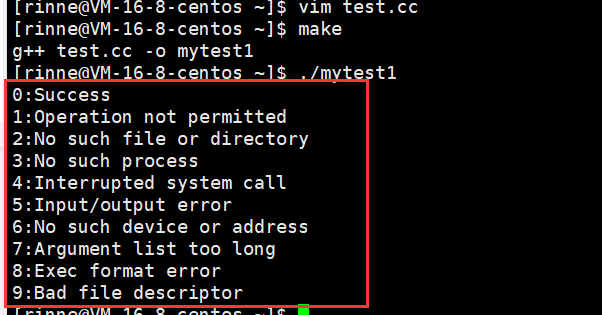文章目录
一、进程退出
main函数return0是为什么?
main函数返回的是进程的退出码
- 输出最近一次进程的退出码
echo $?
1. 进程退出场景
- 代码运行完毕,结果正确
- ——————,结果不正确
- 代码异常终止(程序崩溃)
2. 查看每个退出码所传递的信息
strerror
1 #include <iostream>
2 #include <string.h>
3 using namespace std;
4
5
6 int main()
7 {
8 for(int i = 0; i < 10; i++)
9 {
10 cout << i << ":" << strerror(i) << endl;
11 }
12 return 0;
13 }
14
~

可以看出最多是133

3. 终止进程
exit,强制退出,参数是退出码
二者效果相似,且会将保存在缓冲区的数据输出,缓冲区刷新
exit(EXIT_SUCCESS);
return 0;
_exit 终止进程,但不刷新缓冲区(以及后续的收尾工作)
总结:进程退出三种方式:mian函数return0;exit;_exit;
进程退出,0S层面做了什么:
系统层面,少了一个进程: free PCB, free, mm_ struct, free 页表和各种映射关系,代码+数据申请的空间也要释放掉
二、进程等待
为什么要让父进程等待呢?
通过获取子进程退出的信息,能够得知子进程执行结果。
可以保证时序问题,子进程先退出。父进程后退出
进程退出的时候会先进入僵尸状态,会造成内存泄漏的问题,需要通过父进程wait, 释放该子进程占用的资源
1. wait
#include<sys/types.h>
#include<sys/wait.h>
pid_t wait(int*status);
返回值:
成功返回被等待进程pid,失败返回-1。
参数:
输出型参数,获取子进程退出状态,不关心则可以设置成为NUL
测试:
1 #include <iostream>
2 #include <stdlib.h>
3 #include <string.h>
4 #include <sys/types.h>
5 #include <sys/wait.h>
6 #include <unistd.h>
7 #include <stdio.h>
8
9 using namespace std;
10
11
12 int main()
13 {
14 pid_t id = fork();
15
16 if(id == 0)
17 {
18 int i = 5;
19 while(i--)
20 {
21 printf("child_ PID : %d\n", getpid());
22 sleep(1);
23 }
24 exit(-1);
25 }
26
27 sleep(10);
28 pid_t pid = wait(NULL);
29 printf("father return :%d\n", pid);
30
31
32 return 0;
33 }

2. waitpid
当正常返回的时候waitpid返回收集到的子进程的进程PID
pid_ t waitpid(pid_t pid, int *status, int options);
waitpid(pid, null, 0);//指定子进程
waitpod(-1, null, 0);//任意子进程
3. status参数
- wait和waitpid,都有一个status参数,该参数是一个输出型参数,由操作系统填充
- 如果传递NULL,表示不关心子进程的退出状态信息。 否则,操作系统会根据该参数,将子进程的退出信息反馈给父进程
status是一个整型 linux下4字节,32bit,只使用低16bit,其他未使用


系统提供了宏:
-
WIFEXITED(status): 若为正常终止子进程返回的状态,则为真。(查看进程是否是正常退出)
-
WEXITSTATUS(status): 若WIFEXITED非零,提取子进程退出码。(查看进程的退出码)
if( WIFEXITED(status) && ret == pid )
{
printf("code is :%d.\n",WEXITSTATUS(status));
}
else
{
printf("wait child failed, return.\n");
}
4. options参数
**阻塞等待:**一直等到子进程退出。
本质是:
- **阻塞的本质:**其实是进程的PCB被放入了等待队列,并将进程的状态改为S状态
- **返回的本质:**进程的PCB从等待队列拿到R队列,从而被CPU调度
**非阻塞等待:**需要多次发出请求询问是否结束,轮询访问
pid_t pid = fork(); int status = 0; int ret = waitpid(pid, &status, WNOHANG);WNOHANG(which no hang(停住了)): 若pid指定的子进程没有结束,则waitpid()函数返回0,不予以等待。若正常结束,则返回该子进程的ID。
三、进程的程序替换
如果想要子进程进行一个新的程序
当进程调用一种exec函数时,该进程的用户空间代码和数据完全被新程序替换,从新程序的启动例程开始执行。调用exec并不创建新进程,所以调用exec前后该进程的id并未改变
1. execl进程替换
**execl函数:**如果调用失败,不会执行该代码
int execl(const char *path, const char *arg, ...);
//全路径/文件名 //可变参数列表怎么执行就写什么命令,结束用NULL

1 #include <iostream>
2 #include <stdlib.h>
3 #include <string.h>
4 #include <sys/types.h>
5 #include <sys/wait.h>
6 #include <unistd.h>
7 #include <stdio.h>
8
9 using namespace std;
10
11
12 int main()
13 {
14 cout << "hello world" << endl;
15
16 execl("/usr/bin/ls", "ls", "-a", "-l", "-d", NULL);
17
18 cout << "hello world" << endl;
19
20
21 return 0;
22 }

程序替换的本质是把程序的进程代码+数据加载进特定进程的上下文中
C/C++程序运行,必须的先加载到内存中!
如何加载? 加载器:exec*程序替换函数
用fork创建子进程后执行的是和父进程相同的程序(但有可能执行不同的代码分支)
子进程调用一种exec函数执行另一个程序,此时发生写实拷贝,不影响父进程



